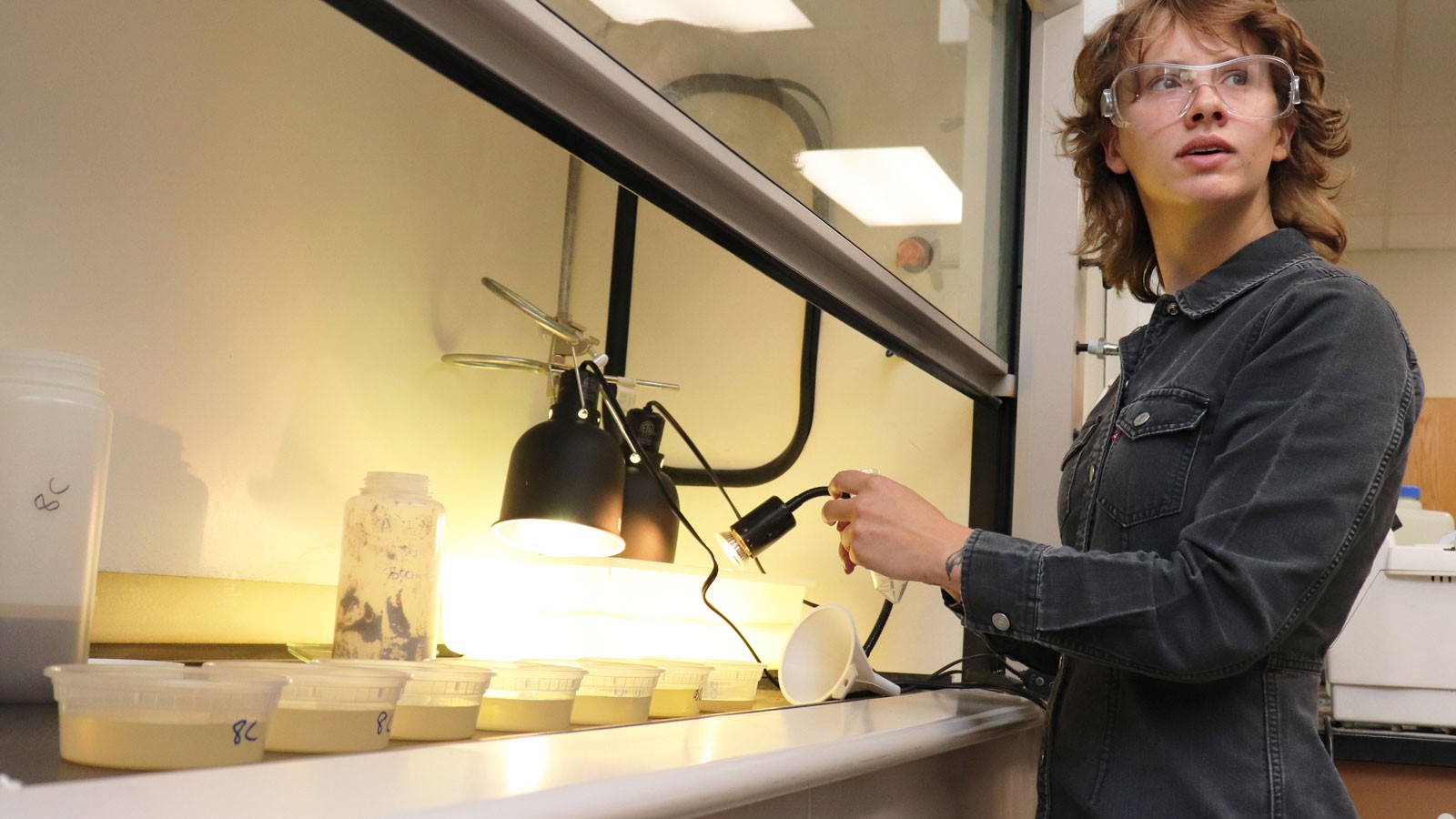Shallow End: USU Geologist Studies Seismic Behavior of California's San Andreas Fault
Doctoral student Alexandra DiMonte studies shallow creep events along the southern segment of the sliding boundary between the Pacific and North American Plates.
By Mary-Ann Muffoletto |
USU Geosciences doctoral student Alex DiMonte separates clay samples from fault rock collected from the southern segment of California's San Andreas Fault for analysis. The Aggie scholar says an endowed scholarship enables travel that supports her dissertation research. (Photo: USU/M. Muffoletto)
Arriving at Utah State University in Fall 2019, geosciences graduate student Alexandra DiMonte couldn’t foresee a global pandemic that would disrupt classes and research activities.
“I was fortunate to have the opportunity to participate in field trip to the San Andreas Fault with USU Geosciences Professor Susannah Jänecke during Spring Semester 2020, right before the university had to shut down in-person classes and activities,” says DiMonte, who earned a master’s degree in geology from USU in 2022, and is current working toward a doctoral degree. “Visiting the fault piqued my interest in pursuing study of the area for my graduate research.”
With her master’s thesis, DiMonte explored how some faults, including the San Andreas Fault and Utah’s Wasatch Fault, slip slowly between earthquakes.
“From exhumed faults, brought up to the Earth’s surface from depth, we can observe a rich record of fault processes and slip informed by fault rock structures, textures and chemistry,” she says.
In particular, DiMonte examined hematite, a common iron oxide mineral found on fault surfaces that stores a chronological record of past fault activity, using a technique called uranium-thorium-helium dating.
“Hematite can be analyzed using a radioisotopic system called (U-Th)/He thermochronometry, which constrains a fault’s slip history,” she says.
Among some faults, like the Wasatch Fault here in Utah, intense heat from the friction of geologic movement of two sides imparts a signature, much like a fingerprint, in hematite, DiMonte says. However, on faults in the San Andreas fault system, hematite textures and thermochronometry data don’t show these signatures, suggesting they slipped slowly.
“This phenomenon motivates me to look for other signatures of earthquakes and slow slip in the San Andreas Fault,” she says.
For her doctoral dissertation, DiMonte is studying the material properties of clay-rich rocks and sediments of the southern San Andreas fault, to determine how they influence fault behavior.
“The area I’m studying includes fault materials that once resided at less than a kilometer below the Earth’s surface,” she says. “We are examining rocks from a geologically recent time period — less than a million years old — to understand how the fault is behaving today, and if and how an earthquake will happen in the future.”
The last major earthquake for the area occurred about 300 years ago, DiMonte says. Triggered and episodic shallow creep events occurring at the study site accommodated some of the slip, but understanding the segment’s behavior requires characterization of the fault materials.
To that end, DiMonte uses the scanning electron microscope, or SEM, in USU’s Microscopy Core Facility to closely examine research site samples and experimental samples from deformation apparatuses.
“We’re characterizing the friction of these materials, when stress is applied,” she says.
To advance her research, DiMonte, who works with USU faculty mentor Alexis Ault, regularly travels to Brown University to conduct further experiments and process data. Back at USU, she prepares clay samples to identify specific minerals with X-ray diffraction (XRD) and K-Ar dating, a technique for measuring the ratio of radioactive potassium to argon in the samples.
“Obtaining this data was critical to my dissertation research,” she says. “And I’m grateful I received the USU Department of Geosciences J. Stewart Williams Scholarship to fund this portion of my work.”
She adds: “We’re observing that, below the groundwater table and above it during wet periods, the influence of water on the mechanical behavior of clays and couple effects of water between clay particles — or pore pressure — may prime the shallow San Andreas fault network to enhance how earthquakes rupture to the surface.
DiMonte is among graduate students featured by the College of Science during the university’s Oct. 5 “A” Day of Giving. The college’s 2023 area of giving focus is graduate student scholarships.
WRITER
Mary-Ann Muffoletto
Public Relations Specialist
College of Science
435-797-3517
maryann.muffoletto@usu.edu
CONTACT
Alexandra DiMonte
Doctoral Student
Department of Geosciences
435-797-1273
alex.dimonte@usu.edu
TOPICS
Research 878stories STEM 163stories Geosciences 74storiesComments and questions regarding this article may be directed to the contact person listed on this page.







